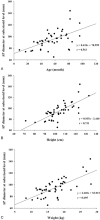Analysis of the functionally-narrowest portion of the pediatric upper airway in sedated children
- PMID: 29979422
- PMCID: PMC6076178
- DOI: 10.1097/MD.0000000000011365
Analysis of the functionally-narrowest portion of the pediatric upper airway in sedated children
Abstract
The narrowest portions of the pediatric larynx are the glottis and subglottic region. However, the pliable and paralyzed subglottic region, acting like a curtain, is no resistance when passing an endotracheal tube. Therefore, the 'functionally' portion of the pediatric upper airway, which may be the most vulnerable to damage during intubation, is the unyielding portion below the cricoid cartilage. We investigated the functionally-narrowest portion below the cricoid cartilage.Computed tomography (CT) was performed under deep sedation. CT images were used for measurement of dimensions and cross-sectional area (CSA) of the larynx at the level of the cricoid, subcricoid, and trachea. We analyzed the anteriorposterior (AP) diameter, transverse diameter, and CSA below the cricoid cartilage (at the cricoid, subcricoid, and tracheal levels).CT images of 46 children from 8 months to 96 months were reviewed from electric medical record (EMR). The mean ± SD of AP diameter was the shortest at the subcricoid level (cricoid, 105.7 ± 15.8 mm; subcricoid, 94.6 ± 15.3 mm; and trachea, 101.5 ± 15.7 mm; P < .001). The mean ± SD of transverse diameter was the shortest at the trachea level (cricoid, 99.8 ± 12.2 mm; subcricoid, 102.5 ± 13.7 mm; and trachea, 98.8 ± 10.7 mm; P = .01). The mean ± SD of CSA was the smallest at the subcricoid level (cricoid, 8781.5 ± 1963.3 mm; subcricoid, 8425.0 ± 2025.7 mm; and trachea, 8523.7 ± 1791.1 mm; P = .02). The AP diameter at the subcricoid level was narrower than the transverse diameter at trachea level (mean difference: 4.2 mm, 95% confidence interval [CI]: 0.7-7.7, P = .02).Since the most susceptible portion for airway damage is unyielding portion, our findings suggest that, functionally, the narrowest portion of the pediatric larynx is located in the subcricoid region.
Conflict of interest statement
The authors declare no conflicts of interest.
Figures



Similar articles
-
Age-based analysis of pediatric upper airway dimensions using computed tomography imaging.Pediatr Pulmonol. 2016 Mar;51(3):267-71. doi: 10.1002/ppul.23232. Epub 2015 Jun 17. Pediatr Pulmonol. 2016. PMID: 26083203
-
Upper airway in infants-a computed tomography-based analysis.Paediatr Anaesth. 2017 May;27(5):501-505. doi: 10.1111/pan.13126. Epub 2017 Mar 2. Paediatr Anaesth. 2017. PMID: 28256046
-
Pediatric laryngeal dimensions: an age-based analysis.Anesth Analg. 2009 May;108(5):1475-9. doi: 10.1213/ane.0b013e31819d1d99. Anesth Analg. 2009. PMID: 19372324
-
The anatomy of the pediatric airway: Has our knowledge changed in 120 years? A review of historic and recent investigations of the anatomy of the pediatric larynx.Paediatr Anaesth. 2018 Jan;28(1):13-22. doi: 10.1111/pan.13281. Epub 2017 Nov 17. Paediatr Anaesth. 2018. PMID: 29148119 Review.
-
Functional anatomy of the upper airway.Emerg Med Clin North Am. 1988 Nov;6(4):639-69. Emerg Med Clin North Am. 1988. PMID: 3056703 Review.
Cited by
-
Ultrasonography measurement of glottic transverse diameter and subglottic diameter to predict endotracheal tube size in children: a prospective cohort study.Sci Rep. 2022 Sep 8;12(1):15215. doi: 10.1038/s41598-022-19668-6. Sci Rep. 2022. PMID: 36075958 Free PMC article.
-
Analysis of Pediatric Acute Upper Airway Pathology During Local Wildfires and Increased PM 2.5 Burden.Otolaryngol Head Neck Surg. 2025 Jun;172(6):2072-2081. doi: 10.1002/ohn.1191. Epub 2025 Mar 10. Otolaryngol Head Neck Surg. 2025. PMID: 40062612
-
Spatial aerosol deposition correlated to anatomic feature development in 6-year-old upper airway computational models.Comput Biol Med. 2022 Oct;149:106058. doi: 10.1016/j.compbiomed.2022.106058. Epub 2022 Sep 5. Comput Biol Med. 2022. PMID: 36103743 Free PMC article.
References
-
- Bayeux Tubage de larynx dans le croup. Presse Med 1897;20:1–4.
-
- Motoyama EK. The shape of the pediatric larynx: cylindrical or funnel shaped? Anesth Analg 2009;108:1379–81. - PubMed
-
- Litman RS, Weissend EE, Shibata D, et al. Developmental changes of laryngeal dimensions in unparalyzed, sedated children. Anesthesiology 2003;98:41–5. - PubMed
-
- Dalal PG, Murray D, Messner AH, et al. Pediatric laryngeal dimensions: an age-based analysis. Anesth Analg 2009;108:1475–9. - PubMed
-
- Wani TM, Bissonnette B, Rafiq Malik M, et al. Age-based analysis of pediatric upper airway dimensions using computed tomography imaging. Pediatr Pulmonol 2016;51:267–71. - PubMed
Publication types
MeSH terms
LinkOut - more resources
Full Text Sources
Other Literature Sources

